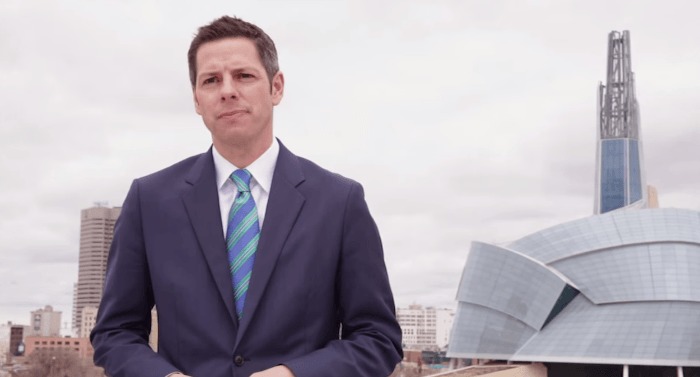So much for Bowmentum. Less than a month after the municipal election in which Brian Bowman was swept into the mayor’s chair with a remarkable mandate, it would appear City Hall has resumed its firmly suburbanist agenda with the initial approval of yet another sprawling residential subdivision. On November 18, the Lord Selkirk—West Kildonan Community Committee approved a plan by Landmark Planning & Design to develop a sizeable parcel of land between Leila Avenue and a future extension of the Chief Peguis Trail known as Precinct E.
Does newly elected, allegedly urbanist mayor Brian Bowman have the temerity to put the brakes on this development? Or will one of the first major acts of his administration be the rubber-stamping of this proposed 1,800-home blight?
Blight, what blight? After all, the proposed subdivision is an “infill development” that will feature lakes, parks, walking trails, multi-family development! Buzzwords that trigger an almost Pavlovian response from the City. Alleged amenities that made Waverley West too good to pass up. The same kinds of things that do nothing to increase density or car-free liveability, but do wonders for developers’ home-building brochures.
[related_content slugs=”things-were-supposed-to-get-better-canada-and-sexual-violence-against-women,the-ndps-leadership-crisis,decisions-were-made-a-case-for-autonomous-and-empowered-judicial-inquiries,the-shameful-end-of-greg-selingers-premiership” description=”More from Kris Ade” position=”right”]
Granted, Precinct E, which has yet to receive a coma-inducing name like Sage Creek, is only a fraction of the size of Waverley West. (Whereas that development will ultimately accommodate over 40,000 residents, Precinct E will only house approximately 5,400.) However, Waverley West is nowhere near capacity, which makes the approval of yet another subdivision elsewhere in the city even more puzzling. While the good ship Waverley West has sailed, Precinct E remains dry-docked. Surely it makes more sense to halt any further suburban development until that monstrosity at the city’s southwest axis is completed?
During the campaign, Bowman made a number of ambitious commitments that would suggest he is against the expansion of Winnipeg’s sub-urban and ex-urban communities. He made the revitalization and redevelopment of Winnipeg’s downtown a top priority. He spoke passionately about the importance of public transit and sustainability. He even railed against the antiquated and regressive property tax (which has too often fuelled the city’s reckless suburban expansion), promising instead to negotiate a new revenue-generating arrangement with the Province. Putting the kibosh on the Precinct E proposal would seem like a no-brainer for Winnipeg’s new mayor.
While nowhere near as expensive as Waverley West has been for the city, Precinct E will no doubt cost the city a lot of money, immediately and in perpetuity. Roads, sewers, water lines, street lights, bus shelters, sidewalks; snow-clearing, transit connections, libraries and community centers; police, fire and paramedic coverage. So much money.
Despite that old chestnut from the developers and the construction industry, property tax revenues from said developments will never make up for the capital and maintenance costs the city will ultimately incur. A 2013 report from Ottawa-based think-tank Sustainable Prosperity into the true costs of suburban sprawl found, for example:
- Across just seventeen of the more than forty new developments underway or planned in Edmonton, net costs have been projected to exceed revenues by nearly $4 billion over sixty years.
- The City of London, Ontario found that over a fifty-year period sprawling growth would entail capital costs $2.7 billion higher, and operating costs about $1.7 billion higher, than for a compact growth scenario.
In both of those cases and countless others across the country, municipalities continue to miss or ignore the many hidden costs associated with suburban sprawl. Winnipeggers will be paying a hefty price for existing suburban misadventures, Waverley West especially, for decades to come. Why throw good money after bad?
Save for lining the pockets of those individuals and companies that collectively own the lands that comprise Precinct E, there is absolutely no reason for pursuing this suburban development. And so again, will newly-elected Mayor Bowman use his considerable “Bowmentum” to stop this proposal (and others like it), and instead walk the talk of his mayoral campaign?
After all, Bowman could redirect the infrastructure money required to service the subdivision towards his multi-billion-dollar campaign commitment to complete every leg of the city’s rapid transit master plan. Or does the city have money for both? Not likely. Even if it did, the questions remain: why another suburb to further hollow-out the city’s core; to detract from much-needed re-investment in existing, inner-city neighbourhoods?
Simply put, Winnipeg can no longer afford to expand outwards. Already one of the lowest density municipalities in Canada, Winnipeg is woefully and dangerously unsustainable. This must change, and soon. Climate change due to human-induced global warming is already wreaking havoc on the city’s already crippled infrastructure; the city’s ageing population less and less likely to shoulder the costs of the city’s upkeep in the years ahead; the Province’s dire financial situation casting an even darker cloud over the already gloomy fiscal horizon.
Sure, halting Precinct E will do little to solve Winnipeg’s larger, long-term problems, but doing so would serve as a welcome signal that change is coming. And change must come. Is Mayor Bowman the one to bring it?
—
Sustainable Prosperity’s full report—Suburban Sprawl: Hidden Costs, Identifying Innovations—is available through their website.
